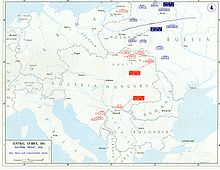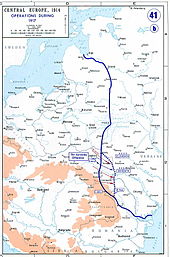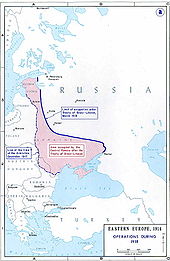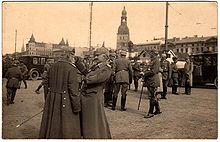Eastern Front - Picture
More about World War 1

|
|
Eastern Front
Date: Date
17 August 1914 - 3 March 1918
Location
Central and Eastern Europe
Result
Decisive Central Powers victory
Collapse of the Russian Empire
Events leading to the Russian Revolution
Treaty of Brest-Litovsk, Treaty of Bucharest
Date: 17 August 1914 - 3 March 1918
Location: Central and Eastern Europe
Result: Decisive Central Powers victory
Collapse of the Russian Empire
Events leading to the Russian Revolution
Treaty of Brest-Litovsk, Treaty of Bucharest
Belligerents:
: German Empire
Austria-Hungary
Ottoman Empire
Bulgaria
Commanders and leaders:
: Paul von Hindenburg
Erich Ludendorff
Leopold of Bavaria
Max Hoffmann
Conrad von Hx¶tzendorf
Nikola Zhekov
Stefan Toshev
Strength:
: Ottoman Empire:117.000-130.000
Casualties and losses:
: & 1.4 Million dead & missing
Collapse of the Russian Empire
Events leading to the Russian Revolution
Treaty of Brest-Litovsk, Treaty of Bucharest
Vistula River - Åx³dź - Limanowa - Bolimx³w - 2nd Masurian Lakes - Gorlice-Tarnx³w - Great Retreat - Sventiany Offensive - Lake Naroch - Brusilov Offensive - Kowel - Kerensky Offensive - Operation Albion

Picture - The Eastern Front, as it was in 1914
The Eastern Front used to be a theatre of war during World War I in Central and, primarily, Eastern Europe. The term is in contrast to the Western Front. Despite the geographical separation, the events in the two theatres strongly influenced each other. In Russian sources, the war was sometimes called the Second Fatherland War.
Theatre of war
The length of the front in the east was much longer than in the west. The theatre of war was roughly delimited by the Baltic Sea in the west and Minsk in the east, and Saint Petersburg in the north and the Black Sea in the south, a distance of more than 1,600 kilometres (990 mi). This had a drastic effect on the nature of the warfare. While World War I on the Western Front developed into trench warfare, the battle lines on the Eastern Front were much more fluid and trenches never truly developed. This was because the greater length of the front ensured that the density of soldiers in the line was lower so the line was easier to break. Once broken, the sparse communication networks made it difficult for the defender to rush reinforcements to the rupture in the line to mount a rapid counteroffensive and seal off a breakthrough. In short, on the Eastern front the side defending did not have the overwhelming advantages it had on the Western front. However, as in the Napoleonic Wars and like World War II, Russian forces were familiar with their own ground which provided a natural advantage for the Russian emperor's land forces.
1914
At the outbreak of the war, Tsar Nicholas II appointed his cousin, Grand Duke Nicholas as Commander-in-Chief of the Imperial Russian Army. On mobilization, the Russian army totalled 115 infantry and 38 cavalry divisions with nearly 7,900 guns (7,100 field guns, 540 field howitzers and 257 heavy guns). Divisions were allocated as follows: 32 infantry and 10.5 cavalry divisions to operate against Germany, 46 infantry and 18.5 cavalry divisions to operate against Austria-Hungary, 19.5 infantry and 5.5 cavalry divisions for the defence of the Baltic Sea and the Black Sea littorals, and 17 infantry and 3.5 cavalry divisions were to be transported in from Siberia and Turkestan.
The war in the east began with the Russian invasion of East Prussia and the Austro-Hungarian province of Galicia. The first effort quickly turned to a defeat following the Battle of Tannenberg in August 1914. The second incursion was completely successful, with the Russians controlling almost all of Galicia by the end of 1914. Under the command of Nikolai Ivanov and Aleksey Brusilov, the Russians won the Battle of Galicia in September and began the Siege of PrzemyÅl, the next fortress on the road towards Krakx³w.
This early Russian success in 1914 on the Austro-Russian border was a reason for concern to the Central Powers and caused considerable German forces to be transferred to the East to take pressure off the Austrians, leading to the creation of the new German Ninth Army. At the end of 1914 the main focus of the fighting shifted to central part of Russian Poland, west of the river Vistula. The October Battle of the Vistula River and the November Battle of Åx³dź brought little advancement for the Germans, but at least kept the Russians at a safe distance.
The Russian and Austro-Hungarian armies continued to clash in and near the Carpathian Mountains throughout the winter of 1914-1915. Przemysl fortress managed to hold out deep behind enemy lines throughout this period, with the Russians bypassing it in order to attack the Austro-Hungarian troops further to the west. They made some progress, crossing the Carpathians in February and March 1915, but then the Germans sent relief and stopped further Russian advance. In the meantime, Przemysl was almost entirely destroyed and the Siege of Przemysl ended in a defeat for the Austrians.
1915
In 1915 the German command decided to make its main effort on the Eastern Front, and accordingly transferred considerable forces there. To eliminate the Russian threat the Central Powers began the campaign season of 1915 with the successful Gorlice-Tarnow Offensive in Galicia in May 1915. After the Second Battle of the Masurian Lakes, the German and Austro-Hungarian troops in the Eastern Front functioned under a unified command. The offensive soon turned into a general advance and then a strategic retreat by the Russian army. The cause of the reverses suffered by the Russian army was not so much errors in the tactical sphere, as the deficiency in technical equipment - particularly in artillery and ammunition. Only by 1916 did buildup of Russian war industries increase production of war material and improve the supply situation.

Picture - The Eastern Front, as of 1917
By mid-1915, the Russians had been expelled from Russian Poland and hence pushed hundreds of kilometers away from the borders of the Central Powers, removing the threat of Russian invasion of Germany or Austria-Hungary. At the end of 1915 German-Austrian advance was stopped on the line Riga-Jakobstadt-Dvinsk-Baranovichi-Pinsk-Dubno-Ternopil. The general outline of this front line did not change until the Russian collapse in 1917.
1916
By June 1916 there were 140 Russian infantry divisions against 105 Austro-German infantry divisions and 40 Russian cavalry divisions against 22 Austro-German. The mobilization of industry and increase of imports enabled the Russian army to resume offensive. A large offensive on the southwestern front under the leadership of General Aleksey Brusilov (the Brusilov Offensive) started in June. The attack, aimed against the part of the front held by Austro-Hungarians, was initially a spectacular success. The Russian army advanced to a depth of 50-70 kilometres (31-43 mi), capturing several hundred thousand prisoners and several hundred guns. The arrival of important enemy reinforcements from the west, the defeat of the Romanians, and failure of Russia's western allies to shake German defenses, brought the Russian advance to an end in September.
On 14 August 1916, Romania entered the war on the side of the Entente and had a successful offensive until September. After that it started to suffer great losses and several defeats from German-Austrian-Bulgarian-Ottoman forces, as the Romanian Army was poorly equipped and their Russian allies offered little support on the front.
1917-1918

Picture - Territory lost by Russia under the Treaty of Brest-Litovsk
By 1917, the Russian economy finally neared collapse under the strain of the war effort. While the equipment of the Russian armies actually improved due to the expansion of the war industry, the food shortages in the major urban centres brought about civil unrest, which led to the abdication of the Tsar and the February Revolution. The large war casualties also created disaffection and mutinous attitudes in the army, which was fueled by Bolshevik agitators and the Russian Provisional Governmentâs new liberalization policies towards the army (stripping officers of their mandate by giving wide sweeping powers to "soldier committees", the abolition of the death penalty). The very last offensive undertaken by the Russian Army in the war was the brief and unsuccessful Kerensky Offensive in July 1917.

Picture - High-ranking German officers in Riga after its fall, 3 September 1917
On 29 November 1917, the Communist Bolsheviks took power under their leader Vladimir Lenin. Leninâs new Bolshevik government tried to end the war but the Germans demanded enormous concessions. Finally, in March 1918, the Treaty of Brest-Litovsk was signed and the Eastern Front ceased to be a war zone. While the treaty was practically obsolete before the end of the year, it did provide some relief to Bolsheviks, who were embroiled in a civil war, and affirmed the independence of Finland, Estonia, Latvia, Ukraine, and Lithuania. The Germans were able to transfer substantial forces to the west in order to mount an offensive in France in the spring of 1918. However, this offensive failed to achieve a decisive breakthrough and the arrival of more and more American units in Europe was sufficient to offset the German advantage. Even after the Russian collapse, about a million German soldiers remained tied up in the east until the end of the war, attempting to run a short-lived addition to the German Empire in Europe. In the end, Germany and Austria lost all their captured lands, and more, under various treaties (such as the Treaty of Versailles) signed after the armistice in 1918.
Casualties
The Russian casualties in the First World War are difficult to estimate, due to the poor quality of available statistics. Some official Russian sources list 775,400 battlefield fatalities. More recent Russian estimates give 900,000 battlefield deaths and 400,000 dead from combat wounds, or a total of 1,300,000 dead. This is about equal to the casualties suffered by France and Austria-Hungary and about one-third less than those suffered by Germany.
Cornish gives a total of 2,006,000 military dead (700,000 killed in action, 970,000 died of wounds, 155,000 died of disease and 181,000 died while POWs). This measure of Russian losses is similar to that of the British Empire, 5% of the male population in the 15 to 49 age group. He says civilian casualties were five to six hundred thousand in the first two years, and were then not kept, so a total of over 1,500,000 is not unlikely. He has over five million men passing into captivity, the majority during 1915.
When Russia withdrew from the war, 3,900,000 Russian POWs were in German and Austrian hands. This by far exceeded the total number of prisoners of war (1,300,000 million) lost by the armies of Britain, France and Germany combined. Only the Austro-Hungarian Army, with 2,200,000 POWs, came even close.
Cornish, Nik (2006). The Russian Army and the First World War. Stroud: Tempus. ISBN 1862272883.
Stone, Norman (2004). Eastern Front 1914-1917. Penguin Global. ISBN 0140267255.
Russia U.S.S.R. : a complete handbook. New York: W.F. Payson, 1933. Section on armed forces by A. Zaitsov.
More aircraft.
Source: WikiPedia